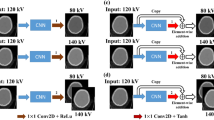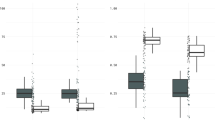Abstract
Deep learning (DL) has shown great potential in conversions between various imaging modalities. Similarly, DL can be applied to synthesize a high-kV computed tomography (CT) image from its corresponding low-kV CT image. This indicates the feasibility of obtaining dual-energy CT (DECT) images without purchasing a DECT scanner. In this study, we investigated whether a low-to-high kV mapping was better than a high-to-low kV mapping. We used a U-Net model to perform conversions between different kV CT images. Moreover, we proposed a double U-Net model to improve the quality of original single-energy CT images. Ninety-eight patients who underwent brain DECT scans were used to train, validate, and test the proposed DL-based model. The results showed that the low-to-high kV conversion was better than the high-to-low kV conversion. In addition, the DL-based DECT images had better signal-to-noise ratios (SNRs) than the true (original) DECT images, but at the expense of a slight loss in spatial resolution. The mean CT number differences between the true and DL-based DECT images were within \(\pm\) 1 HU. No statistically significant difference in CT number measurements was found between the true and DL-based DECT images (p > 0.05). The DL-based DECT images with improved SNR could produce low-noise virtual monoenergetic images. Our preliminary results indicate that DL has the potential to generate brain DECT images using single-energy brain CT images.










Similar content being viewed by others
References
Flohr T G, McCollough C H, Bruder H, Petersilka M, Gruber K, Süss C, Grasruck M, Stierstorfer K, Krauss B, Raupach R, Primak A N, Küttner A, Achenbach S, Becker C, Kopp A, Ohnesorge B M: First performance evaluation of a dual-source CT (DSCT) system. Eur Radiol 16:256–268, 2006
McCollough C H, Leng S, Yu L, Fletcher J G: Dual- and multi-energy CT: principles, technical approaches, and clinical applications. Radiology 276:637–653, 2015
Goo H W, Goo J M: Dual-energy CT: new horizon in medical imaging. Korean J Radiol 18:555, 2017
van Elmpt W, Landry G, Das M, Verhaegen F: Dual energy CT in radiotherapy: Current applications and future outlook. Radiother Oncol 119:137–144, 2016
Naruto N, Itoh T, Noguchi K: Dual energy computed tomography for the head. Jpn J Radiol 36:69–80, 2018
Freiherr G: Do Community Hospitals Need Dual-Energy CT? HitachimedCom 2–14, 2016
Henzler T, Fink C, Schoenberg S O, Schoepf U J: Dual-energy CT: radiation dose aspects. Am J Roentgenol 199:S16–25, 2012
Padole A, Ali Khawaja R D, Kalra M K, Singh S: CT radiation dose and iterative reconstruction techniques. Am J Roentgenol 204:W384–392, 2015
Lee T-Y, Chhem R K: Impact of new technologies on dose reduction in CT. Eur J Radiol 76:28–35, 2010
Shen D, Wu G, Suk H-I: Deep learning in medical image analysis. Annu Rev Biomed Eng 19:221–248, 2017
Maier A, Syben C, Lasser T, Riess C: A gentle introduction to deep learning in medical image processing. Z Med Phys 29:86–101, 2019
Liu F, Jang H, Kijowski R, Bradshaw T, McMillan A B: Deep learning MR imaging–based attenuation correction for PET/MR imaging. Radiology 286:676–684, 2018
Leynes A P, Yang J, Wiesinger F, Kaushik S S, Shanbhag D D, Seo Y, Hope T A, Larson P E Z: Zero-echo-time and Dixon deep pseudo-CT (ZeDD CT): direct generation of pseudo-CT images for pelvic PET/MRI attenuation correction using deep convolutional neural networks with multiparametric MRI. J Nucl Med 59:852–858, 2018
Liao Y, Wang Y, Li S, He J, Zeng D, Bian Z, Ma J: Pseudo dual energy CT imaging using deep learning-based framework: basic material estimation. Med. Imaging 2018 Phys. Med. Imaging, vol. 10573, SPIE; 2018, p. 172
Zhao W, Lv T, Gao P, Shen L, Dai X, Cheng K, Jia M, Chen Y, Xing L: A deep learning approach for dual-energy CT imaging using a single-energy CT data. 15th Int. Meet. Fully Three-Dimensional Image Reconstr. Radiol. Nucl. Med., vol. 11072, SPIE; 2019, p. 27
Wang Z, Bovik A C, Sheikh H R, Simoncelli E P: Image quality assessment: from error visibility to structural similarity. IEEE Trans Image Process 13:600–612, 2004
Ronneberger O, Fischer P, Brox T: U-Net: Convolutional networks for biomedical image segmentation. Proc Int Conf Med Image Comput Comput Interv 234‐241, 2015
Bishop C M: Training with noise is equivalent to Tikhonov regularization. Neural Comput 7:108–116, 1995
Rifai S, Glorot X, Bengio Y, Vincent P: Adding noise to the input of a model trained with a regularized objective. ArXiv 1104.3250, 2011
Breiman L: Bias, variance, and arcing classifiers. Tech Rep 460 Dep Stat Univ California, Berkeley, CA 1996
Li J-H, Tsai C-Y, Huang H-M: Assessment of hepatic fatty infiltration using dual-energy computed tomography: a phantom study. Physiol Meas 35:597–606, 2014
Böning G, Feldhaus F, Adelt S, Kahn J, Fehrenbach U, Streitparth F: Clinical routine use of virtual monochromatic datasets based on spectral CT in patients with hypervascularized abdominal tumors - evaluation of effectiveness and efficiency. Acta Radiol 60:425–432, 2019
Primak A N, Giraldo J C R, Eusemann C D, Schmidt B, Kantor B, Fletcher J G, McCollough C H: Dual-source dual-energy CT with additional tin filtration: Dose and image quality evaluation in phantoms and in vivo. AJR Am J Roentgenol 195:1164–1174, 2010
Dabov K, Foi A, Katkovnik V, Egiazarian K: Image denoising by sparse 3D transform-domain collaborative filtering. IEEE Trans on Image Process 16: 2080–2095, 2007
Veraart J, Fieremans E, Jelescu I O, Knoll F, Novikov D S: Gibbs ringing in diffusion MRI. Magn Reso Med 76:301-314, 2016
Goodfellow I J, Pouget-Abadie J, Mirza M, Xu B, Warde-Farley D, Ozair S, Courville A, Bengio Y: Generative adversarial networks. Adv Neural Inf Process Syst 2672–2680, 2014
Funding
This work was supported by MOST 109-2221-E-002-049 from Ministry of Science Technology, Taiwan.
Author information
Authors and Affiliations
Corresponding author
Ethics declarations
Conflict of Interest
The authors declare that they have no conflicts of interest.
Disclosure
All authors have approved the manuscript for submission. The content of the manuscript has not been published, or submitted for publication elsewhere.
Additional information
Publisher’s Note
Springer Nature remains neutral with regard to jurisdictional claims in published maps and institutional affiliations.
Appendix
Appendix
An example of true (left column) and filtered (middle column) DECT images, and difference images (right column) between the true and filtered DECT images. The filtered DECT images were the true DECT images with a 2D Gaussian filter (GF) and sigma = 1. All CT images are displayed in a window width of 80 HU and a window level (center) of 40 HU
An example of true (left column) and filtered (middle column) DECT images, and difference images (right column) between the true and filtered DECT images. The filtered DECT images were the true DECT images with a 2D Gaussian filter (GF) and sigma = 1. All CT images are displayed in a window width of 80 HU and a window level (center) of 40 HU
An example of true (left column) and filtered (middle column) DECT images, and difference images (right column) between the true and filtered DECT images. The filtered DECT images were the true DECT images with a block-matching and three-dimensional filtering (BM3D) and sigma = 20. All CT images are displayed in a window width of 80 HU and a window level (center) of 40 HU
An example of true (left column) and filtered (middle column) DECT images, and difference images (right column) between the true and filtered DECT images. The filtered DECT images were the true DECT images with a block-matching and three-dimensional filtering (BM3D) and sigma = 20. All CT images are displayed in a window width of 80 HU and a window level (center) of 40 HU
k‐Space energy density of true and DL-based a 80-kV and b 140-kV CT images (Fig. 5) as a function of the distance to the k‐space center. The results indicated that the spatial resolution of DL-based DECT images was slightly degraded as compared to that of true DECT images. However, the loss of spatial resolution observed in the DL-based DECT images was less severe than that observed in the true DECT images with a 2D Gaussian filter (GF) and sigma = 1. Moreover, a similar degradation in the spatial resolution was observed when comparing the proposed DL-based DECT images with the true DECT images denoised using a block-matching and three-dimensional filtering (BM3D) and sigma = 20
Rights and permissions
About this article
Cite this article
Liu, CK., Liu, CC., Yang, CH. et al. Generation of Brain Dual-Energy CT from Single-Energy CT Using Deep Learning. J Digit Imaging 34, 149–161 (2021). https://doi.org/10.1007/s10278-020-00414-1
Received:
Revised:
Accepted:
Published:
Issue Date:
DOI: https://doi.org/10.1007/s10278-020-00414-1









